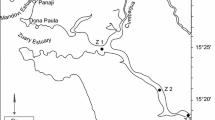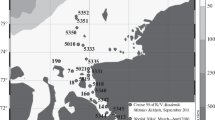Abstract
In June 1992, an extensive investigation programme was carried out in the turbidity zone of the Elbe river. Special attention was paid to salinity and suspended particulate matter (SPM) and their influence on bacteria, phytoplankton, zooplankton, mysids and fish. SPM was separated into three fractions of different settling velocities. Mean settling velocity (ws) was 0.05 cm s−1. The major part of SPM belonged to the slow settling fraction (ws<0.02 cm s−1).
Bacterial exoenzymatic activity showed a positive correlation with SPM and chlorophyll-a content, and also to total dissolved free amino acids.
Phytoplankton biomass reached maximum values of 5.7 μg chlorophyll-a l−1 at ebb tide. Chlorophyll-a correlated negatively with salinity, indicating riverine input of phytoplankton. A positive correlation was found between chlorophyll-a and dissolved oxygen.
Abundance of zooplankton species and their developmental stages varied over the tidal cycles; abundance of cirriped larvae and copepodite stages of the dominant speciesEurytemora affinis (Copepoda, Crustacea) was positively correlated with salinity. Individual filtering rates (IFR) ofEurytemora affinis were negatively affected by the SPM content of the water. Maximum IFR for adults was 7.2 ml h−1. Community grazing reached maximum rates of 30.3 ml l−1 h−1 (i.e. 72.7% d−1).
The dominant mysidNeomysis integer showed maximum abundance at night, possibly resulting from diel vertical migration. Abundance ofN. integer was positively correlated with SPM content.
The fish community, consisting of 17 fish species, was characterised by high densities of smelt (Osmerus eperlanus). A positive correlation was found between salinity and abundance of typical marine fish species, such as sprat (Sprattus sprattus). Similar temporal variation of abundance of smelt, sprat, andEurytemora copepodites indicates processes of habitat preference of these planktivorous fish in relation to optimal food supply.
SPM was the factor controlling both distribution of organisms and the turnover of nutrients. Salinity only was important for the distribution of organisms.
Similar content being viewed by others
References
ARNDT, E.A. and W. JANSEN, 1986.Neomysis integer (Leach) in the chain of Boddens South of Darss/Zingst (Western Baltic) Ecophysiology and population dynamics. Ophelia, Suppl., 4: 1–15.
BEATTIE, D.M. and H. DE KRUIF, 1978. Population dynamics and biomass production ofNeomysis integer (Leach) in the Bergumermeer. Verh. Internat. Verein. Limnol., 20: 2566–2571.
BEETON, A.M. and J.A. BOWERS, 1982. Vertical migration ofMysis relicta Lovén. Hydrobiologia, 93: 41–51.
BOAK, A.C. and R. GOULDER, 1983. Bacterioplankton in the diet of the calanoid copepodEurytemora sp. in the Humber estuary, England, U.K. Mar. Biol. 73: 139–150.
BREMER, P. and J. VIJVERBERG, 1982. Production, population biology and diet ofNeomysis integer (Leach) in a shallow Frisian lake (The Netherlands). Hydrobiologia, 93: 41–51.
BROCKMANN, U.H. and A. PFEIFFER, 1990. Seasonal changes of dissolved and particulate matter in the turbidity zone of the Elbe river. In: W. Michaelis, Ed., Estuarine water quality management. Ser. Coastal and Estuarine Studies. Springer-Verlag, Berlin, Heidelberg, New York: 327–343.
CHRÓST, R.J., 1991. Preface. In: R.J. Chróst, Ed., Microbial enzymes in the aquatic environments. Brock/Springer series in contemporary bioscience
CHRÓST, R.J., R. WCISLO and G. HALEMEJKO, 1986. Enzymatic decomposition of organic matter by bacteria in a eutrophic lake. Arch. Hydrobiol., 107: 154–165.
CYRUS, D.P. and S.J.M. BLABER, 1987. The influence of turbidity on juvenile marine fishes in estuaries. Part 2. Laboratory studies, comparision with field data and conclusions. J. Exp. Mar. Biol. Ecol., 109: 71–91.
DEBUS, L., T. MEHNER and R. THIEL, 1992. Spatial and diel patterns of migration forNeomysis integer. In: J. Köhn, M.B. Jones and A. Moffat, Ed., Taxonomy, biology and ecology of (baltic) mysids. Rostock University: 79–82.
EISMA, D., J. BOON, R. GROENEWEGEN, V. ITTEKKOT, J. KALF and W.G. MOOK, 1983. Observations on macro-aggregates, particle size and organic composition of suspended matter in the Ems estuary. Mitt. Geol.-Paläont. Inst. Univ. Hamburg. SCOPE/UNEP Sonderband, 55: 295–314.
ELLIOTT, M., M.G. O'REILLY and C.J.L. TAYLOR, 1990. The Forth estuary: a nursery and overwintering area for North Sea fishes. Hydrobiologia, 195: 89–103.
FAGANELI, J., 1989. Sedimentation of partiulate nitrogen and amino acids in shallow coastal waters. (Gulf of Trieste, Northern Adriatic). Mar. Chem., 26: 67–80.
FANGER, H.-U., H.KUHN, W.MICHAELIS, A.MÜLLER and R.RIETHMÜLLER, 1986. Investigation of material transport and load in tidal rivers. Wat. Sci. Techn., 18: Plymouth, 101.
FAST, T., 1993. Zur Dynamik von Biomasse und Primärproduktion des Phytoplanktons im Elbe-Ästuar. Ph. D. Thesis, University of Hamburg.
FORSYTH, D.J. and M.R. JAMES, 1984. Zooplankton grazing on lake bacterioplankton and phytoplankton. J. Plankton. Res., 6: 803–811.
FRANEK, D., 1988. Nahrungsuntersuchungen am juvenilen Stint (Osmerus eperlanus L., 1758) des Barther Boddens. Wiss. Z. Univ. Rostock, N-Reihe, 37: 64–68.
FUHRMAN, J. 1990. Dissolved free amino acid cycling in an estuarine outflow plume. Mar. Ecol. Prog. Ser., 66: 197–203.
GÄTJE, C. and L. KIES, 1990. Microphytobenthos in the Elbe-Estuary: biomass, species composition and primary production measurements with oxygen microelectrodes. In: W. Michaelis, Ed., Coastal and estuarine studies, estuarine water quality management 36. Springer-Verlag, Berlin: 399–402.
GAWLER, M. and R. CHAPUIS, 1987. An improved version of the Haney grazing chamber. Freshwat. Biol., 18: 1–4.
HANEY, J.F., 1971. Anin situ method for the measurement of zooplankton grazing rates. Limnol. Oceanogr., 16: 971–977.
HEERKLOSS, R., 1979. Selektivität der Nahrungsaufnahme, Ingestionsrate und Faecesabgabe beiEurytemora affinis (Poppe) (Copepoda, Calanoida). Wiss. Ztschr. W.-Pieck-Univ. Rostock (Math. nat. R.) 28: 525–529.
HEINLE, D.R., R.P. HARRIS, J.F. USTACH and D.A. FLEMER, 1977. Detritus as food for estuarine copepods. Mar. Biol., 40: 341–353.
HOBBIE, J.E., R.J. DALEY, and S. JASPER, 1977. Use of Nucleopore filters for counting bacteria by fluorescence microscopy. App. Environ. Microbiology, 33: 1225–1228.
HOPPE, H.G., 1983. Significance of exoenzymatic activities in the ecology of brackish water: Measurements by means of methylumbelliferly-substances. Mar. Ecol. Prog. Ser., 11: 299–308.
HORBOWY, J., 1989. A multispecies model of fish stocks in the Baltic Sea Dana, 7: 23–43.
JELONEK, M., 1986. Food of juvenile fish stages of rudd (Scardinius erythrophtalmus L.), roach (Rutilus rutilus L.), and perch (Perca fluviatilis L.) in the heated water of the Rybnik dam reservoir (Southern Poland). Acta Hydrobiol., 28: 451–461.
JØRGENSEN, N.O.G., 1982. Heterotrophic assimilation and occurence of dissolved free amino acids in a shallow estuary. Mar. Ecol. Prog. Ser., 8: 145–159.
KAUSCH, H., 1990. Biological processes in the estuarine environment.- In: W. Michaelis, Ed., Estuarine water quality management. Ser. Coastal and Estuarine Studies 36. Springer-Verlag, Berlin, Heidelberg, New York: 353–361
LAMPERT, W. and B.E. TAYLOR, 1985. Zooplankton grazing in a eutrophic lake: Implications of diel vertical migration. Ecology, 66: 68–82.
MANTOURA, R.F.C. and C.A. LLEWELLYN, 1983. The rapid determination ol algal chlorophyll and carotenoid pigments and their breakdown products in natural waters by the reversed phase High Performance Liquid Chromatography. Anal. Chim. Acta, 151: 297–314.
MELACK, J.M. 1985. Interactions of detrital particulates and plankton. Hydrobiologia, 125: 209–220.
MICHAELIS, W., 1991. Transport von Schweb- und Spurenstoffen. 1989–1991 Report of the Sonderforschungsbereich 327 Tide-Elbe: 57–116.
MOPPER, K. and P. LINDROTH, 1982. Diel and depth variations in dissolved free amino acids and ammonium in the Baltic Sea determined by shipboard HPLC analysis. Limnol. Oceanogr., 27: 336–347.
NAESJE, T.F., B. JONSSON, L. KLYVE and O.T. SANDLUND, 1987: Food and growth of age-0 smelts, Osmerus eperlanus, in a Norwegian fjord lake. J. Fish Biol., 30: 11–126.
NAGATA, T. and D.L. KIRCHMAN, 1990. Filtration-induced release of dissolved free amino acids: application to cultures of marine protozoa. Mar. Ecol. Prog. Ser., 68: 1–5.
NÖTHLICH, I., 1980. Hydrobiologische Untersuchungen zur Kennzeichnung der Salzgehalts-verhältnisse im Elbe-Aestuar. Bundesanstalt fürGewässerkunde, 5. Bericht N2/350.53.
PEITSCH, A., 1992. Untersuchungen zur Populationsnynamik und Produktion vonEurytemora affinis im Brackwasserbereich des Elbe-Ästuars. Ph. D. Thesis, University of Hamburg, Germany.
PORTER, K.G. and Y.S. FEIG, 1980. The use of DAPI for identification and counting aquatic microflora. Limnol. Oceanogr., 25: 943–948.
PULS, W. and H. KÜHL, 1989. Die Sinkgeschwindigkeit von Elbeschwebstoff bei Lauenburg und Bunthaus, August 1989. GKSS (Geesthacht) report 89/E/54.
RAYMONT, J.E.G., J. AUSTIN and E. LINFORD, 1964. Biochemical studies on marine zooplankton. I. The biochemical composition ofNeomysis integer. J. Cons. perm. int. expl. mer. 28: 354–363.
RELEXANS, J.C., M. MEYBECK, G. BILLEN, M. BREUGEAILLY, H. ETCHEBER and M. SOMVILLE, 1988. Algal and microbiological processes involved by particulate organic matter dynamics in the Loire Estuary. Estuar. Coast. Shelf Sci., 27: 625–644.
RICHMANN, S., D.R. HEINLE, and R. HUFF, 1977. Grazing by adult estuarine calanoid copepods of the Chesapeak Bay. Mar. Biol., 42: 69–84.
RIEDEL-LORJÉ, J.C., N. MÖLLER-LINDENHOF and B. Vaessen, 1992. Salzgehalts- und Trübstoffverhältnisse in dem oberen Brackwassergebiet der Elbe. Hamburg, Wassergütestelle Elbe, 145 pp.
RIPPINGALE, R.J. and P.A.M. CROSSLAND, 1993. Food availability and salinity tolerance in the copepodEurytemora affinis POPPE. Arch. Hydrobiol./Suppl. 75: 357–362.
RODDIE, B.D., R.J.G. LEAHEY and A.J. BERRY, 1984. Salinity-temperature tolerance andEurytemora affinis (POPPE) (Copepoda, Calanoida) in relation to its distribution in the zooplankton of the upper reaches of the Forth estuary. J. Exp. Mar. Biol. Ecol., 79: 191–211.
ROMAN, M.R., 1984. Utilisation of detritus by the copepodAcartia tonsa. Limnol. Oceanogr., 29: 949–959.
SCHNESE, W. and R. HEERKLOSS, 1978. Nutrition-biological studies on the zooplankton of the chain of boddens south of the Darß-Zingst peninsula: Determination of feeding and assimilation rates by means of 14C under field conditions. Kieler Meeresforsch., (Sonderheft 4): 267–274.
SEPULVEDA, A., R. THIEL and W. NELLEN, 1993. Distribution patterns and production of early life stages of European smelt,Osmerus eperlanus L., from the Elbe river. ICES, C.M. 1993/M:39.
THIEL, R., 1992. Quantitative estimation of mysids —Neomysis integer (Leach, 1814) — and their production within a typical southern Baltic Bay. In: J. Köhn, M.B. Jones and A. Moffat, Ed., Taxonomy, biology and ecology of (baltic) mysids. Rostock University: 73–78.
UTERMÖHL, H., 1958. Zur Vervollkommnung der quantitativen Phytoplankton-Methodik. Int. Ver. theor. angew. Limnol., 9: 1–39.
VAN DENSEN, W.L.T., 1985 Feeding behaviour of major 0+ fish species in a shallow, eutrophic lake (Tjeukemeer, The Netherlands). Z. angew. Ichthyol., 2: 49–70.
Author information
Authors and Affiliations
Rights and permissions
About this article
Cite this article
Bernát, N., Köpcke, B., Yasseri, S. et al. Tidal variation in bacteria, phytoplankton, zooplankton, mysids, fish and suspended particulate matter in the turbidity zone of the Elbe estuary; Interrelationships and causes. Netherlands Journal of Aquatic Ecology 28, 467–476 (1994). https://doi.org/10.1007/BF02334218
Issue Date:
DOI: https://doi.org/10.1007/BF02334218




